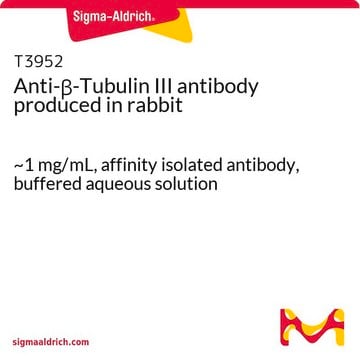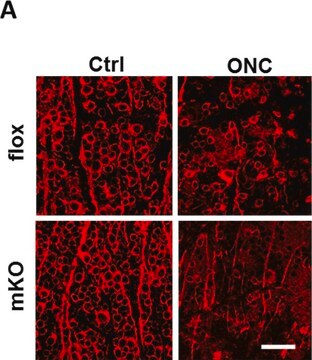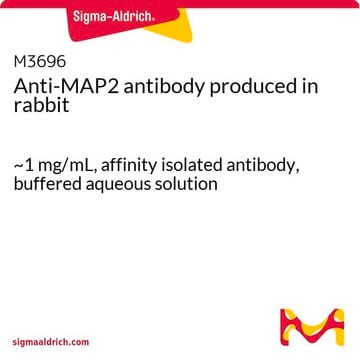T2200
Anti-β-Tubulin III antibody produced in rabbit

affinity isolated antibody, buffered aqueous solution
Sinónimos:
Anti-Tuj 1
About This Item
Productos recomendados
biological source
rabbit
conjugate
unconjugated
antibody form
affinity isolated antibody
antibody product type
primary antibodies
clone
polyclonal
form
buffered aqueous solution
mol wt
antigen ~55 kDa
species reactivity
rat, human, mouse
enhanced validation
knockout
Learn more about Antibody Enhanced Validation
technique(s)
immunoprecipitation (IP): 10 μg using RIPA extract (250 μg) of cultured rat PC12 cells
indirect immunofluorescence: 10-20 μg/mL using rat PC12 cells
western blot: 0.2-0.4 μg/mL using whole extracts of mouse brain or cultured human neuroblastoma SH-SY5Y cells
UniProt accession no.
shipped in
dry ice
storage temp.
−20°C
target post-translational modification
unmodified
Gene Information
human ... TUBB3(10381)
mouse ... Tubb3(22152)
rat ... Tubb3(246118)
¿Está buscando productos similares? Visita Guía de comparación de productos
General description
α/β-Tubulin, an integral component of microtubules, is present in almost all eukaryotic cells.
α/β-Tubulin occurs mostly as soluble (approx. 100-110 kDa) heterodimeric sets of α- and β-tubulin isotypes or as polymers in assembled microtubules. β-Tubulin III (also designated β-4 chain) is found in the brain and dorsal root ganglia and appears to be localized to neurons of the central and peripheral nervous system. β-tubulin III is also found in Sertoli cells of the testis, spermatozoa tails, certain lung cells, and apparently some breast stromal cells.
Specificity
Immunogen
Application
- Immunofluorescence
- Immunostaining
- Western blotting
- immunofluorescence
- immunostaining
- western blotting
- indirect immunoperoxidase assay (IPA)
Biochem/physiol Actions
Physical form
Preparation Note
For extended storage, freeze in working aliquots. Repeated freezing and thawing is not recommended. Storage in frost-free freezers is also not recommended. If slight turbidity occurs upon prolonged storage, clarify the solution by centrifugation before use. Working dilutions should be discarded if not used within 12 hours.
Other Notes
Disclaimer
Not finding the right product?
Try our Herramienta de selección de productos.
related product
Storage Class
12 - Non Combustible Liquids
wgk_germany
WGK 1
flash_point_f
Not applicable
flash_point_c
Not applicable
Certificados de análisis (COA)
Busque Certificados de análisis (COA) introduciendo el número de lote del producto. Los números de lote se encuentran en la etiqueta del producto después de las palabras «Lot» o «Batch»
¿Ya tiene este producto?
Encuentre la documentación para los productos que ha comprado recientemente en la Biblioteca de documentos.
Los clientes también vieron
Protocolos
Cultivate ReNcell® human neural stem cells in 3D hydrogels for high-throughput screening using the TrueGel3D® HTS Hydrogel Plate with this protocol.
Cultivate ReNcell® human neural stem cells in 3D hydrogels for high-throughput screening using the TrueGel3D® HTS Hydrogel Plate with this protocol.
Cultivate ReNcell® human neural stem cells in 3D hydrogels for high-throughput screening using the TrueGel3D® HTS Hydrogel Plate with this protocol.
Cultivate ReNcell® human neural stem cells in 3D hydrogels for high-throughput screening using the TrueGel3D® HTS Hydrogel Plate with this protocol.
Nuestro equipo de científicos tiene experiencia en todas las áreas de investigación: Ciencias de la vida, Ciencia de los materiales, Síntesis química, Cromatografía, Analítica y muchas otras.
Póngase en contacto con el Servicio técnico

















